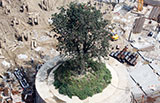Full Text: Historical Witness to Ethnic Equality, Unity and Development in Xinjiang
(Xinhua) Updated: 2015-09-24 13:13III. Constantly Strengthening the Foundations of Development
Over the past six decades, Xinjiang's economy has achieved steady and rapid development, which has accelerated the region' s modernization and laid a solid foundation for improved standards of living and progress in various social programs.
Marked improvement has been observed in Xinjiang' s overall strength. Its gross regional product (GRP) was only RMB1.2 billion in 1955 and RMB3.9 billion in 1978. In 2014, it reached RMB927.3 billion, a 116-fold increase over that of 1955 in real terms, with an annual growth rate of 8.3 percent, or 0.2 percentage point higher than China' s average during the same period. Over the years between 2010 and 2014, the average annual growth rate of Xinjiang's GRP was 11.1 percent, 2.5 percentage points higher than the national average. It ranked the fourth of all the country's province-level divisions - its highest ever placing as compared to the 30th in 2009. Xinjiang's per-capita GRP rose to RMB40,648 in 2014 from RMB241 in 1955, about a 24-fold increase in real terms, and a 5.6-percent annual growth. Xinjiang's fiscal revenues and expenditure, no more than RMB170 million and RMB180 million in 1955, grew to RMB128 billion and RMB332 billion in 2014. Over the period from 2010 to 2014, Xinjiang collected a total of RMB454 billion in fiscal revenues, and spent a total of RMB1,308.8 billion.
The gap between urban and rural areas has gradually been narrowed. When the Xinjiang Uygur Autonomous Region was founded, it had only few cities like Urumqi, Kashi (Kashgar), Yining (Ghulja) and Hami (Kumul). Its rural areas remained a closed natural economy. There was a yawning gap between urban and rural areas. After six decades of construction and development, enormous improvement has been observed in the production and living conditions of both urban and rural residents. The ratio of urban to rural population was 15.1:84.9 in 1955. By 2014, it had changed to 46.07:53.93. The ratio of urban residents' income to that of rural residents decreased from 3.2:1 in 2009 to 2.7:1 in 2014, narrower than that in the 11 other provinces and autonomous regions of western China. As Xinjiang's new model of urbanization develops fast, more and more rural residents are moving to the cities and enjoying a modern city life.
The economy of the various areas of Xinjiang is developing in a coordinated way. For historical reasons and due to different conditions, Xinjiang's northern and southern parts, which are divided by the Tianshan Mountains, varied sharply in development. Following the launch of reform and opening-up drive in 1978, Xinjiang decided to first develop the economic belt along the northern slopes of the Tianshan Mountains. Development then extended to other parts and propelled the economic growth of the whole region. In 2014, the gross product of the economic belt reached RMB638.7 billion, accounting for 68.9 percent of Xinjiang's total. The state and the autonomous region have also attached great importance to the development of southern Xinjiang, which is mainly populated by ethnic minorities. Since 2010 in particular, Xinjiang has actively encouraged the development of the southern Xinjiang petroleum, natural gas and chemical industry belt and made strenuous effort to support the development of poverty-stricken areas there by giving them a high priority in funding and projects. The average economic growth rate of the four southern Xinjiang prefectures (Hotan, Aksu and Kashi prefectures, and Kizilsu Kirgiz autonomous prefecture) increased from 10.5 percent in 2009 to 11.2 percent in 2014. A steady growth has been seen in the economic strength of southern Xinjiang, so has a constant improvement in the local people's standards of living.
The economic structure is being steadily optimized. Xinjiang's economy represented a typical pattern featuring traditional agriculture and husbandry as the main component. The ratio of added-value of the primary, secondary and tertiary sectors was 54.4:26.1:19.5 in 1955, and the workforce distribution among the three sectors was 86.9:6.1:7.0. By 2014, the two ratios had improved to 16.6:42.6:40.8 and 45.4:16.0:38.6. A modern industrial structure, with the agricultural sector as the base, manufacturing sector as the spearhead, and service sector as an important component, had taken shape in Xinjiang. After 1978, Xinjiang has stepped up the adjustment of its pattern of ownership. It gave full play to the leading role of public ownership, forming a system of state-owned pillar industries such as petroleum, non-ferrous metals, chemical engineering, steel and coal, as the mainstays, thus having guaranteed the sustained, steady and coordinated growth of the national economy. Meanwhile, it has encouraged, supported and guided the development of the non-public sector. The number of individually owned businesses reached 720,000 in 2014, as compared to the mere 4,168 in 1978. In 2014, private investment in fixed assets was around RMB407 billion, contributing 48.2 percent of the total. Non-public industrial enterprises witnessed a growth rate 5.4 percentage points higher than the industrial sector as a whole, and contributed 33.8 percent to the increment of industrial enterprises with an annual sales revenue of RMB20 million or more.
The infrastructure has become more and more complete. In 2014, 175,500 km of highways were open to traffic, of which 4,316 km were expressways, five times more than in 2009, and Xinjiang had risen to the 12th place among all province-level administrative divisions in the country from the 27th in 2009. A total of 135,000 km of roads served the traffic in rural areas, linking 99.93 percent of towns and 98.71 percent of administrative villages. Some 98 percent of roads between towns and 85 percent of roads between administrative villages were concrete or asphalt ones that meet national standards and requirements. Rail transport in Xinjiang has developed from scratch. In 2014, the overall length of track reached 5,760 km. The region's first high-speed rail between Urumqi and Lanzhou has opened to traffic. A trunk rail network, stretching from east to west and from north to south, connects Xinjiang with other parts of China and with countries in Asia and Europe. In 1978, Xinjiang had only one civil airport and nine regional air routes. By 2014, it had in operation 16 civil airports, and 115 air routes totaling 160,000 km. Thus, Xinjiang now boasts the most airports and the longest air routes in operation of all China's province-level administrative divisions.
Water conservancy projects have led to a great improvement in working and living conditions. Xinjiang had 538 reservoirs with a total storage capacity of 16.908 billion cu m in 2014, as compared to three with a total storage capacity of 52.34 million cu m in 1949. Since 2010, key water conservancy projects bearing on daily life have taken priority in Xinjiang; they included high-efficiency water-saving projects in agriculture, "settlement of herdsmen" water projects, and safe drinking water projects in rural areas. By 2014, high-efficiency water-saving irrigation extended to 27.7 million (1.85 million ha) of farmlands, topping the whole country. Xinjiang had improved irrigation over 3,984,900 (265,660 ha), increased the area of forage land by 3,720,800 (248,053 ha), achieved a net increase of 3.03 million tons in fine forage and hay, and provided water sources for forage lands to safeguard the settlements of 106,000 herding families. Xinjiang's rural areas had a total of 1,315 water works of different sizes, which provided safe drinking water to 11.3 million people, or over 96 percent of the rural population. This has effectively held in check the spread of local infectious and frequently occurring diseases caused by water source pollution.
The power industry is developing rapidly. The South Hami-Zhengzhou +-800 kv UHVDC Transmission Project, Xinjiang's first UHVDC transmission channel sending electricity out of Xinjiang, was put into operation in 2010, and the building of the supporting power projects of the Zhundong-Huadong +-1100 kv UHVDC Transmission Project has started. Xinjiang's 110 kv and 220 kv grids were connected to the 750 kv higher-grade trunk grid. In 2014, Xinjiang had installed power-generating capacity of 55 million kw, and produced 209 billion kwh of electricity. It sent 17.5 billion kwh to other parts of China through transmission lines totaling 65,656 km. The installed capacity using new energy made up 20 percent of the total. A pattern of power generation with thermal power as the mainstay and other forms of power like hydro power, wind power, gas power, photovoltaic power and biomass power in support, has taken shape.
Xinjiang has become an information society. Six decades ago telegrams and post were mainly carried by animals. Now, its communications industry has entered the modern information era. There is Internet coverage across most of the region. In 2014, broadband user numbers exceeded 3 million, and there were 91 mobile phones per 100 people. Around 98 percent of villages had phone line connections and 97 percent of administrative villages had broadband connections. Xinjiang has invested great efforts in raising the status of Urumqi as a regional inward and outward hub in international telecommunication services. Its voice and data services have cross-border connections with more than ten foreign countries, and are able to connect international call services to the whole of the country.
Solid progress has been made in opening up to the outside world. Since 1978, Xinjiang, with state approval, has created 17 first-class ports and 12 second-class ports, in addition to successfully holding 19 Urumqi Foreign Economic Relations and Trade Fairs and four China-Eurasia Expos. It has set up two national economic development zones in Kashi and Khorgos, and the International Center for Cross-Border Cooperation between China and Kazakhstan in Khorgos. Now, there are in Xinjiang 23 state-class industrial clusters. It trades with 186 countries and regions. A new pattern of all-round opening up has taken shape in the region. The value of Xinjiang's combined imports and exports grew from US$51 million in 1955 to almost US$27.7 billion in 2014, averaging an annual growth rate of 11.3 percent. Between 2009 and 2014, applied foreign investment grew at an annual rate of over 12 percent, the volumes of overseas contract business increased by an annual average of 26 percent, and investment outside China went up by an annual average of 25 percent.
The driving force of scientific and technological innovation has remarkably increased in Xinjiang's socio-economic development. Since its founding, Xinjiang has experienced constant increases in its financial input in science and technology, in the size of staff in scientific work, in the variety research platforms and in the number of research achievements, which have gradually led to the establishment of a system of scientific and technological innovation with distinct regional characteristics. The contribution made by scientific and technological progress to the development of agriculture has increased year by year, and improved crop varieties make up over 90 percent of total output. Industrial technology and new and high technology are developing rapidly. Xinjiang leads the country in railway traction transformer technologies, solar and wind power equipment research and manufacturing, and information processing in ethnic minority languages. It has made major technological breakthroughs in the field of resources and environment technology, discovering the petroleum and natural gas reserves in the Tarim Basin. The technologies used in the Tarim Desert Highway and Shelter Forest Project meet the highest international advanced standards.
Steady progress has been made in environmental protection. The ecological system in Xinjiang is extremely fragile, with very limited environmental capacity. Oases account for only 5 percent of the region's total area. Over the past 60 years, and especially since 2010, Xinjiang has made ecological and environmental protection a top priority, insisting on sustainable development of resources and the eco-environment. It has devoted great efforts to protecting and building its ecological system, carefully balancing the interests of economic growth and environmental protection.
Xinjiang protects its environment in accordance with the law. It has drawn up detailed plans and regulations first to protect the environment. It enacted the Zoning Program of Major Functional Areas of Xinjiang Uygur Autonomous Region, and amended or issued a series of local regulations, including the Regulations of Xinjiang Uygur Autonomous Region on Environmental Protection, Regulations of Xinjiang Uygur Autonomous Region on Environmental Protection in the Development of Coal, Petroleum and Natural Gas, Regulations of the Xinjiang Autonomous Region on Wetland Conservation of the Autonomous Region, and Regulations of Urumqi City on Air Pollution Prevention and Control. It now has 31 natural reserves of various kinds at or above the autonomous region level, 18 scenic spots, 52 forest parks, nine geoparks, one world natural heritage site, and 16 wetland parks. Fifty-four percent of its wetland areas are under protection, higher than the national average of 43 percent.
Xinjiang has intensified efforts in ecological and environmental protection programs. Since 2010, Xinjiang has planted or protected over 2,500,000 (166,667 ha) of forests by restricting access to mountain areas. Its total forest area and forest stock rank 14th and 12th in China. Now, belts of shelter-forests built to protect farmlands in all of Xinjiang's 82 counties and county-level cities have merged to form a network, 45 counties and county-level cities have reached the national standards in plains afforestation, and 95 percent of farmlands are effectively protected by the shelter-forests. The forest coverage in oases has risen from 15 percent to 23.5 percent, and a total of 3,258,000 (217,200 ha) of farmland has been returned to forest. Major projects for ecological protection have been launched, such as the Million Ecological Economic Forest Project in Ili Valley and the Project for Prevention and Control of Desertification around Tarim Basin, restoring a total of 24.6 million (1.64 million ha) of degraded lands and enclosing 51.6 million (3.4 million ha) of grassland to prevent grazing. It has curbed water and soil erosion over more than 4,000 sq km of small river valleys. The Comprehensive Reclamation Project of Tarim River Valley has provided emergency water supplies to its lower reaches on 15 occasions, gradually restoring prosperity there. In 2014, water quality was good in 94 percent of major rivers and 67.8 percent of lakes and reservoirs, as compared to 88.3 percent and 43.3 percent in 2009. This is much higher than the national average level.
Xinjiang has put in a lot of work to tackle pollution. Joint prevention and control of air pollution has been carried out in areas like Urumqi and Kuytun-Dushanzi-Wusu. There has been a considerable improvement in the air quality of the regional capital, Urumqi. During 2014, the city had 310 days with good air quality, the best ever for 20 years. Xinjiang has piloted environmental protection in some lakes with good water quality, such as Bosten Lake, Sayram Lake, Ulungur Lake and Kanas Lake. In order to safeguard drinking water, it has made great efforts to protect 367 centralized drinking-water source areas, and comprehensively improved the habitat of 1,836 villages. Xinjiang encourages ecological progress through examples. It has built up two national model cities for environmental protection, 43 national-level eco-friendly prefectures, towns and villages, and 1,057 autonomous region-level eco-friendly prefectures, towns and villages.
- China respects religious freedom, but fights extremism: white paper
- Shanghai slaps three-year ban on entertainers caught doing drugs
- China issues white paper on Xinjiang ethnic equality, unity
- Another corruption suspect repatriated from US to China
- Cross-border triad operation snares 19,000 crime suspects
- Leaders target ongoing bureaucratic inaction
- Beijing to add bicycles, crack down on illegal parking
- Wastewater cleaning finished at Tianjin blast site
- 877 investigated for corruption in financial sector
- Xinjiang gets a helping hand to improve locals' livelihoods







